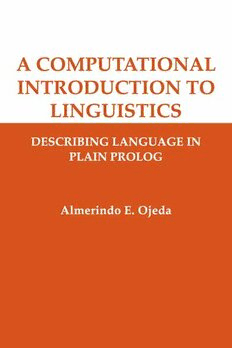
A Computational Introduction to Linguistics PDF
Preview A Computational Introduction to Linguistics
Para Denise Copyright (cid:13)c 2013 CSLI Publications Center for the Study of Language and Information Leland Stanford Junior University Printed in the United States 17 16 15 14 13 1 2 3 4 5 Library of Congress Cataloging-in-Publication Data Ojeda, Almerindo E. A computational introduction to linguistics: describing language in plain PROLOG / Almerindo E. Ojeda. p. cm. – (CSLI lecture notes ; no. 206) Includes bibliographical references and index. ISBN: 978-1-57586657-4 (cloth : alk. paper) ISBN: 978-1-57586659-8 (pbk. : alk. paper) ISBN: 978-1-57586660-4 (electronic) 1. Computational linguistics. 2. Prolog (Computer program language) I. Title. P98.O54 2013 410.285(cid:48)53–dc23 2012050330 CIP CSLI Publications gratefully acknowledges a generous gift from Jill and Donald Knuth in support of scholarly publishing that has made the production of this book possible. ∞ The acid-free paper used in this book meets the minimum requirements of the American National Standard for Information Sciences—Permanence of Paper for Printed Library Materials, ANSIZ39.48-1984. CSLI was founded in 1983 by researchers from Stanford University, SRI International, and Xerox PARC to further the research and development of integrated theories of language, information, and computation. CSLI headquarters and CSLI Publications are located on the campus of Stanford University. CSLI Publications reports new developments in the study of language, information, and computation. In addition to lecture notes, our publicationsincludemonographs,workingpapers,reviseddissertations,and conference proceedings. Our aim is to make new results, ideas, and approaches available as quickly as possible. Please visit our web site at http://cslipublications.stanford.edu/ for comments on this and other titles, as well as for changes and corrections by the author and publisher. Contents Introduction xi 1 Language, Grammar, PROLOG 1 1 A Broad Definition of Language 1 2 Narrowing the Definition of Language 6 3 Time for an Example 9 4 The Goals of a Grammar 15 5 Narrowing the Definition of Grammar Further 25 6 Time for Another Example 30 7 Grammars as Deductive Systems 34 8 Why PROLOG? 38 9 Facing Infinity and Indeterminacy 40 10 Other Preliminaries 41 11 Suggestions for Further Reading 45 12 Exercises 46 2 Phonology: The Nature of Linguistic Sound 51 1 Introduction 51 2 The Phones of Language 53 3 Representing Phones in PROLOG 56 4 Phone Properties 57 5 Natural Classes of Phones 60 6 The Syllable 63 7 The Sounds of English 70 8 Suggestions for Further Reading 73 9 Exercises 73 v vi / A Computational Introduction to Linguistics 3 Semantics: The Nature of Linguistic Meaning 77 1 What is Meaning? 77 2 Implementing the Procedural Theory of Meaning 80 3 Proper Names 84 4 Unary Predicates 86 5 Binary Predicates: Preliminaries 90 6 Binary Predicates: Kinterms 92 7 Binary Predicates: Deictics 98 8 Ternary Predicates 101 9 Sentences: Declaratives 102 10 Sentences: Interrogatives 109 11 Historical Note 111 12 Conclusion 113 13 Suggestions for Further Reading 115 14 Exercises 115 4 Morphology I: The Combinatorics of Words 117 1 Whence Words Come 117 2 Time for a Concrete Example 119 3 Prefixation 124 4 Suffixation 128 5 Infixation 133 6 Circumfixation 138 7 Interfixation 140 8 Reduplication 143 9 Metathesis 147 10 Truncation 148 11 Mutation 151 12 Suppletion 155 13 Recategorization 156 14 Conclusion 157 15 Suggestions for Further Reading 158 16 Exercises 158 Contents / vii 5 Morphology II: The Instantiation of Words 161 1 Missing Phonological Regularities 161 2 Assimilation: First Pass 167 3 Assimilation: Second Pass 173 4 Dissimilation 177 5 Syllabification 182 6 Conclusion 187 7 Historical Note 188 8 Exercises 190 6 Syntax I: The Nominal Clause 193 1 What Syntax is About 193 2 Modification 194 3 Quantification 200 4 Quantification in PROLOG 204 5 The Definite Article 206 6 Proper Names 209 7 Suggestions for Further Reading 212 8 Exercises 215 7 Syntax II: The Verbal Clause 217 1 Verbs and Such 217 2 Argument Structure: Valence 220 3 Argument Structure: Binding 223 4 The Computational Complexity of Argument Structure 232 5 Historical Note 232 6 Exercises 233 8 Syntax III: The Prepositional Clause 237 1 Government 237 2 Prepositional Phrases: Verbal Constructions 241 3 Prepositional Phrases: Nominal Constructions 248 4 More on Oblique Nominal Clauses 252 5 Oblique Nominal Clauses vs. Prepositional Phrases 255 6 Exercises 257 viii / A Computational Introduction to Linguistics 9 Syntax IV: Other Topics 259 1 The Adverbial Clause 259 2 The English Auxiliary 262 3 Inversion 268 4 The Passive Voice 270 5 Control Structures 274 6 Subordination 280 7 Coordination 284 8 Historical Note: Generative Grammar 288 9 Suggestions for Further Reading: Definite Clause Grammar 292 10 Exercises 296 10 Conclusion: The Computational Complexity of Language 299 1 The Computational Complexity of a Grammar 299 2 How Complex Are Our Grammars? 306 3 How Complex is Language? 310 4 Shortcomings of PROLOG Programming 311 5 Facing Left-Recursion 315 6 Some of the Perils Ahead 318 A Getting Started with PROLOG on a Windows Platform 323 1 How to Install a PROLOG Interpreter 323 2 How to Install all the Programs Discussed in this Book 324 3 How to Consult an Installed PROLOG Program 324 4 How to Create a New PROLOG Program 325 5 How to Revise an Installed PROLOG Program 326 6 How to Display Phonetic Characters Properly 326 B Getting Started with PROLOG on a Mac Platform 327 1 How to Install a PROLOG Interpreter 327 2 How to Install all the Programs Discussed in this Book 328 3 How to Consult an Installed PROLOG Program 328 4 How to Create a New PROLOG Program 329 5 How to Revise an Installed PROLOG Program 330 Contents / ix C Tutorials and Other Online Resources for PROLOG 331 D The Efficiency of a Simple Grammar: spanish.swipl 332 E The International Phonetic Alphabet 335 F Fundamental Properties of English Phones 336 G Calculating the Complexity of a Grammar 338 H Program Listings 345 References 429
